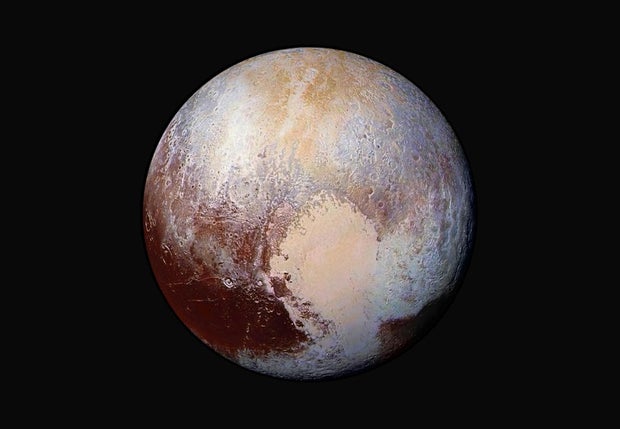Scientists have discovered carbon dioxide and hydrogen peroxide on the surface of Charon, Pluto’s largest moon, offering clues about the origins of the space rock and other celestial objects in the distant solar system.
Using observations from the James Webb Space Telescope‘s near-infrared spectrograph instrument, astronomers at the Southwest Research Institute in Boulder, Colorado, gathered new details about Charon’s composition. Previous exploration at NASA brought basic information to light about the icy mass, including the fact that it was composed mainly of crystalline water ice, ammonia and several other organic materials.
The latest findings are significant, as they “highlight insights into the chemical diversity and evolutionary processes on Charon,” wrote the team of researchers at SWRI in the results of their study. Those results were published Tuesday in the journal Nature Communications.
Technically the largest of Pluto’s five moons, Charon is actually half the size of its parent planet at about 754 miles wide. The relationship between their relatively similar sizes is unusual, according to NASA, so Pluto and Charon together are sometimes referred to as a double dwarf planet system. The New Horizons spacecraft has studied the distant moon before, collecting images of Charon in 2015 as it approached a point in its orbit nearest Pluto. Those images revealed a vast tectonic belt stretched across the equator, hinting at a water-ice ocean present long ago, and, notably, a red-toned region at the massive moon’s northern pole.
NASA/JHUAPL/SwRI via AP
But other fundamental components of Charon’s surface evaded detection, as New Horizons could not capture a spectrum of light wavelengths broad enough to tell the space rock’s full story.
Learning more about the composition of Pluto’s moon could potentially provide insight into Charon’s neighbors in the Kuiper Belt, the researchers said. The belt region encompasses the other rings of the solar system, beyond Neptune’s orbit, and is home to icy objects like dwarf planets as well as some comets.
The ability to identify compounds like carbon dioxide and hydrogen peroxide on the frigid surface of Charon could be valuable for scientists to understand how fundamental processes — radiation exposure from the Sun, for example, or cratering caused by impacts over time — work in this faraway place. Understanding that could in turn help explain how the objects in the Kuiper Belt came to be. It could even shed light on questions about the beginnings of solar system.
“Beyond Neptune, a fascinating collection of small bodies known as Trans-Neptunian Objects (TNOs) orbits the Sun. These objects serve as time capsules, offering scientists a glimpse into the early Solar System,” Silvia Protopapa, the lead researcher on the study, told CBS News. “They are characterized by unique surface compositions, physical properties, and dynamical characteristics that hold clues to the Solar System’s origins.”
More research needs to be done to determine which compounds on the surface of objects like Charon “are pristine” and “which have been modified over time” by external factors, Protopapa added, noting that all those variables can change the mass’ original state. In addition, their surfaces are continuously exposed to space radiation and micrometeoroid impacts, which can alter their original state.
“Understanding this distinction is crucial for piecing together the nature of the primordial disk from which these objects formed 4.5 billion years ago,” she said.

